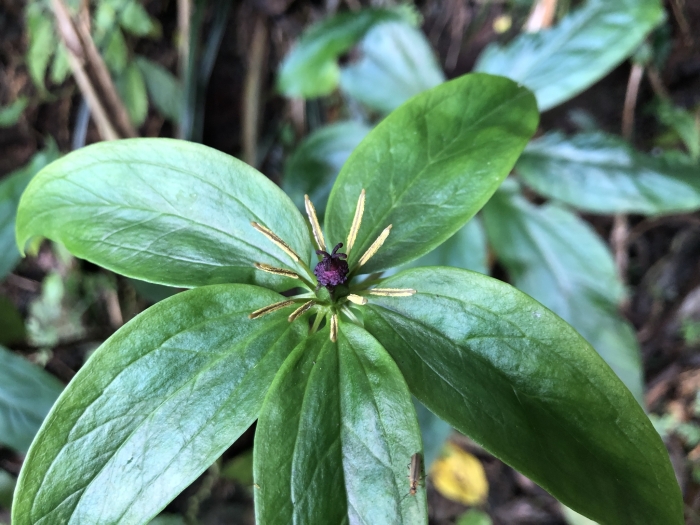Herb Paris
(Paris polyphylla)
Herb Paris (Paris polyphylla)
/
/

Cheng-Tao Lin
CC BY 4.0
Image By:
Cheng-Tao Lin
Recorded By:
Copyright:
CC BY 4.0
Copyright Notice:
Photo by: Cheng-Tao Lin | License Type: CC BY 4.0 | License URL: http://creativecommons.org/licenses/by/4.0/ | Rights Holder: Cheng-Tao Lin | Publisher: iNaturalist | Date Created: 2019-04-22T09:46:35-07:00 |


































Estimated Native Range
Summary
Paris polyphylla, commonly known as Herb Paris, is a perennial herb native to cool temperate woodlands in the Himalayas and East Asia. It thrives in the understory of deciduous forests, where it enjoys the moist, humus-rich soil and the dappled shade provided by the canopy above. This plant typically grows to a height of 90 cm (3 ft) and spreads out about 30 cm (1 ft) wide. The distinctive foliage of Paris polyphylla consists of a single whorl of broad leaves beneath a solitary, star-shaped flower with greenish-yellow petals and prominent stamens, blooming in late spring to early summer. The flowers are not particularly showy, but they have a unique architectural quality that can add interest to shade gardens.
Herb Paris is valued for its unusual foliage and flower structure, making it a conversation piece in woodland gardens or when planted under deciduous trees. It is also appreciated for its low maintenance once established. The plant’s preference for shade and moist soil conditions should be noted, as it does not do well in full sun. It requires consistently moist soil that should not be allowed to dry out, especially during the summer months. A generous layer of mulch in the autumn helps to retain soil moisture and protect the rhizomes. While it is not typically prone to serious diseases or pests, snails and slugs can sometimes be problematic. It is important to plant the rhizome correctly, with the pointy shoot facing upwards and covered with about 5 cm (2 in) of soil. Over time, with minimal disturbance, the plants will naturalize and form attractive colonies.CC BY-SA 4.0
Herb Paris is valued for its unusual foliage and flower structure, making it a conversation piece in woodland gardens or when planted under deciduous trees. It is also appreciated for its low maintenance once established. The plant’s preference for shade and moist soil conditions should be noted, as it does not do well in full sun. It requires consistently moist soil that should not be allowed to dry out, especially during the summer months. A generous layer of mulch in the autumn helps to retain soil moisture and protect the rhizomes. While it is not typically prone to serious diseases or pests, snails and slugs can sometimes be problematic. It is important to plant the rhizome correctly, with the pointy shoot facing upwards and covered with about 5 cm (2 in) of soil. Over time, with minimal disturbance, the plants will naturalize and form attractive colonies.CC BY-SA 4.0
Plant Description
- Plant Type: Herb
- Height: 1-2 feet
- Width: 0.5-1 feet
- Growth Rate: Slow
- Flower Color: Yellow, Green
- Flowering Season: Summer
- Leaf Retention: Deciduous
Growth Requirements
- Sun: Full Sun, Part Shade
- Water: Medium
- Drainage: Slow, Medium
Common Uses
Low Maintenance
Natural Habitat
native to cool temperate woodlands in the Himalayas and East Asia
Other Names
Common Names: Himalayaormbär, Qi Ye Yi Zhi Hua
Scientific Names: , Paris polyphylla, Daiswa polyphylla, Paris brevipetala, Paris polyphylla subsp. polyphylla,
GBIF Accepted Name: Paris polyphylla Sm.